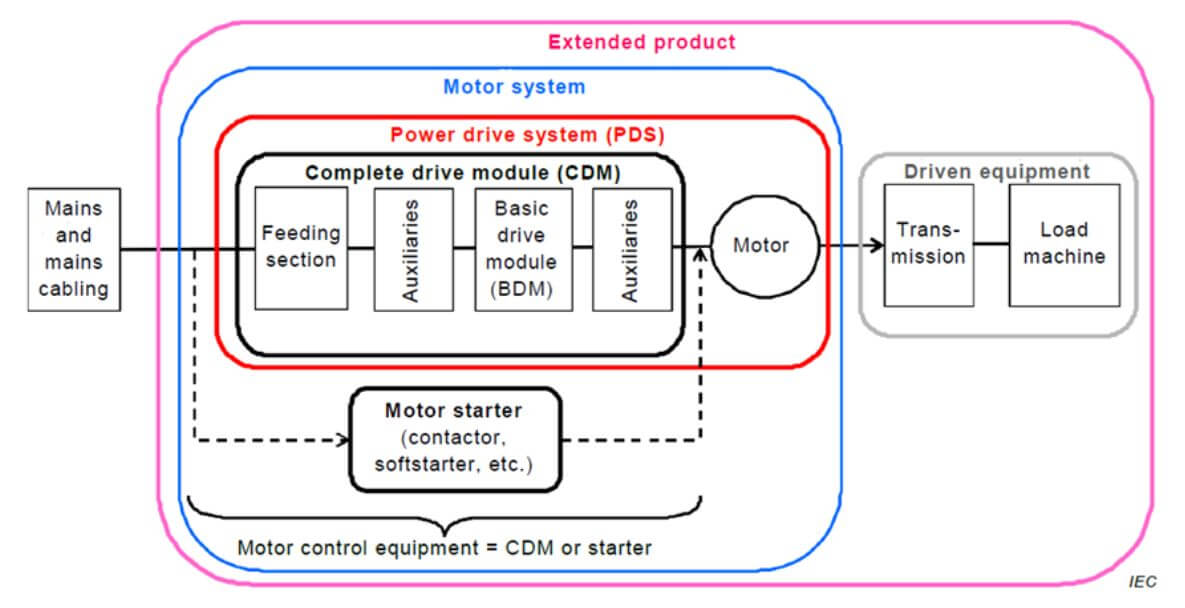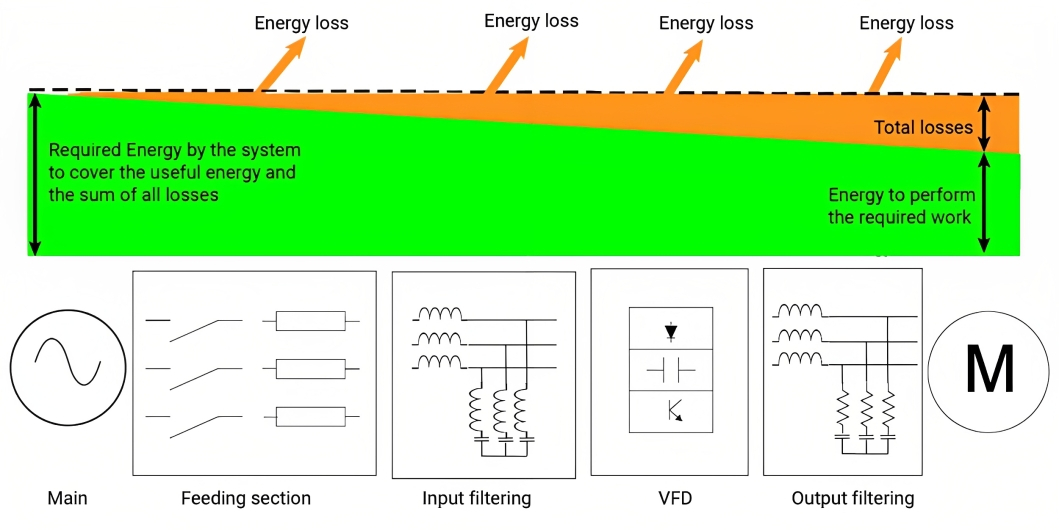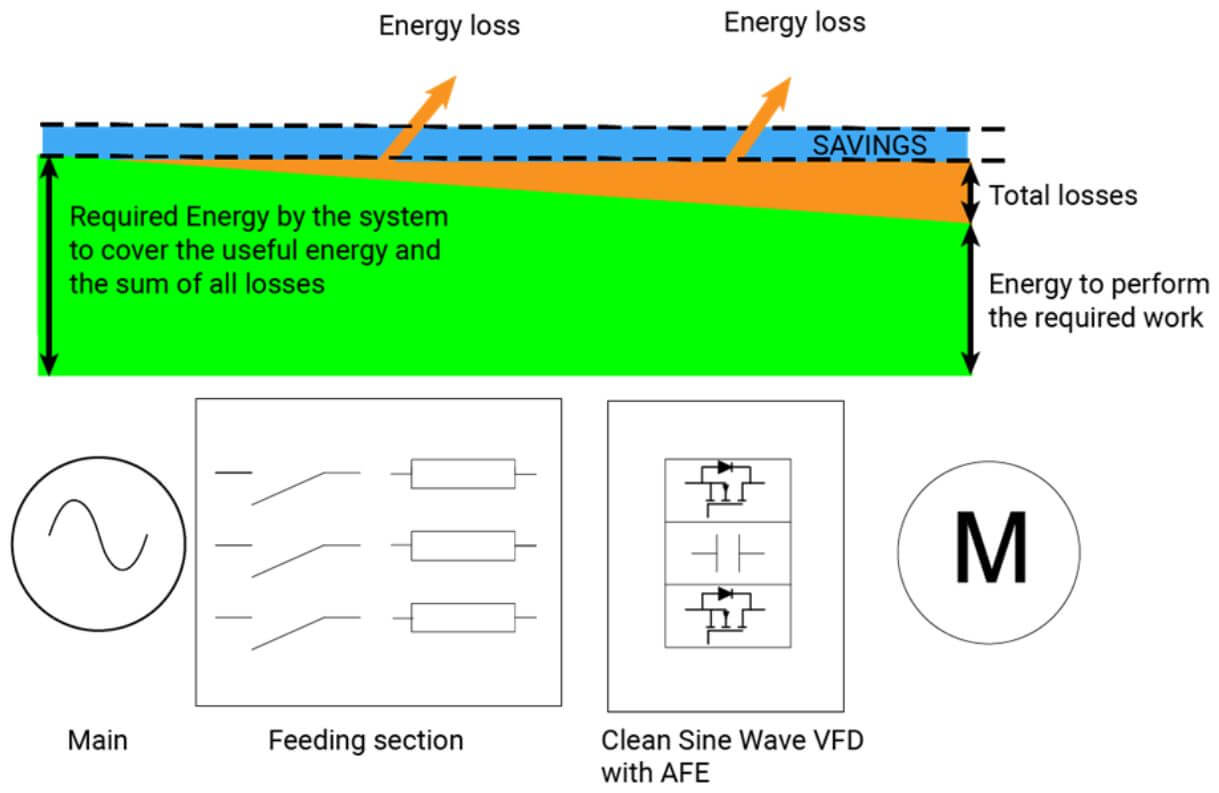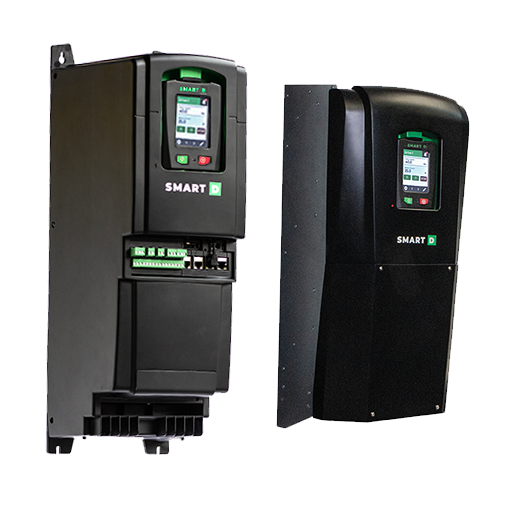Energy Efficiency
- Home
- Energy Efficiency
Rethinking Efficiency to Unlock Savings in Motor Control
In the past two decades, there has been a push for ever more efficient devices in the world of motor control where it is estimated that nearly half of our electricity is consumed by electrical motor-systems.

The standard IEC61800-9 part 1 and part 2 introduces the concept of extended product. Not looking anymore at each component individually but considering the complete chain from the source of energy till its end usage.
Let’s browse the chain backward: from the end-usage to the source through a simple example:
A pump needs a certain amount of energy when displacing a fluid.
This energy is delivered by a motor through a mechanical transmission equipment.
The motor receives its energy from a complete drive module system.
The complete power drive module is connected to the energy source.
Each single element of this chain is delivering energy to the next element in the chain, while losing some level of energy depending on its structure and operation. It is this efficiency and loss of each component that defines its impact on the rest of the system.
Decision making: Efficiency vs loss
| System A | System B | |
|---|---|---|
| Efficiency | % | % |
| Losses | W | W |
| Power Consumption | kW | kW |
| Cost | $ | $ |
KPIs to compare efficiency VS loss between 2 systems
Efficiency and losses have different impacts on decision making. Efficiency is a percentage-based performance indicator, while losses are measured in Watts.
However, Watts alone don’t indicate if they are low or high. The real measure is in the power consumed and billed in kW and $. The IEC61800-9 standard emphasizes considering system losses over percentage-based indicators.
While efficiency matters in system selection, calculating energy costs is crucial for overall expenses. In a 20-year operating period, the initial purchase cost is only 2%, while energy costs make up 90% along with maintenance and downtime impact.
Choosing a Smart drive system can greatly affect energy bills and provide other benefits.
Energy Saving with Variable Frequency Drive
It has been demonstrated that the control of a motor with a variable frequency drive, instead of a direct-on-line starter, is the source of huge savings.
Where are the savings coming from?
Let us take the example where, to get the biggest energy saving, a variable frequency drive (VFD) is used to control a motor driving a centrifugal pump.
| Speed ratio | Mechanical power required % |
|---|---|
| 100% | 100% |
| 90% | 73% |
| 80% | 51% |
| 75% | 42% |
| 60% | 22% |
| 50% | 13% |
| 40% | 6% |
| 30% | 3% |
As a kind reminder, the affinity laws of a standard variable-torque centrifugal pump demonstrate that the power or the energy consumption varies as the cube of the speed, pressure or head varies as the square of the speed, and flow or volumes varies linearly with the speed.
Controlling the speed of the pump upon the real need of pressure or flow is then a huge potential of saving.
When the pump turns at 90% of its nominal speed, it only requires 73% of its rated power, and only 42% when turning at 75% of its nominal speed
Using any variable frequency drive to control the motor of a centrifugal variable pump instead of a direct-on-line (DOL) starter allows to unlock those savings, by delivering the right speed accordingly to the actual need of flow or pressure.
The savings are easy to estimate.
For example, let us imagine that this pumping equipment requires 13 HP of power to perform its work, producing the desired output flow and pressure. Assuming that the pump has been correctly sized.
| Speed ratio | Time ratio | Mechanical power required % |
|---|---|---|
| 100% | 20% | 100% |
| 90% | 0% | 73% |
| 80% | 0% | 51% |
| 75% | 40% | 42% |
| 60% | 0% | 22% |
| 50% | 40% | 13% |
| 40% | 0% | 6% |
| 30% | 0% | 3% |
| 20% | 0% | 1% |
| 10% | 0% | 0% |
| 100% |
Without going into all the details to optimize the motor choice, the common and basic usage is to choose a motor with a nameplate power rating more than the pump required power. A 15HP motor (average FLA 27 A for a 3-phase 460V motor), being the next nominal size above 13HP, can be selected.
When selecting an IE3 class motor, the system uses a motor with an efficiency of about 92%.
Driving a 13HP pump (excluding any transmission in between), its load ratio is 13/15=85%.
To estimate the potential savings, we simply compare with the very same motor controlled by a DOL starter. Its full load power = motor HP x 0.746 x load ratio / efficiency = 10.33 kW.
Using a variable frequency drive, it’s relevant to estimate the time ratio of the above speeds’ ratio. This can be made from observations of similar motor+VFD or take the following assumption as set of values for the comparison.
Applying those mechanical power required ratio to the previous full load power of 10.33kW; and considering their time ratio, a simple spreadsheet gives:
| Speed ratio | Time ratio | Mechanical power required % | Mechanical power required kW | Time Weighted power |
|---|---|---|---|---|
| 100% | 20% | 100% | 10.34 | 2.07 |
| 90% | 0% | 73% | 7.54 | 0.00 |
| 80% | 0% | 51% | 5.29 | 0.00 |
| 75% | 40% | 42% | 4.36 | 1.74 |
| 60% | 0% | 22% | 2.23 | 0.00 |
| 50% | 40% | 13% | 1.29 | 0.52 |
| 40% | 0% | 6% | 0.66 | 0.00 |
| 30% | 0% | 3% | 0.28 | 0.00 |
| 20% | 0% | 1% | 0.08 | 0.00 |
| 10% | 0% | 0% | 0.01 | 0.00 |
| 100% |
The sum of powers for each speed ratio is a statistical value of 4.33 kW for one unit of time.
With a system running 24/7 all the year long, it’s 8736 hours of operation.
Then simply 8736×4.33 = 37821 kWh consumed by the system over one year.
This has to be compared with 8736×10.33 = 90243 kWh consumed by the system with DoL starter.
A huge saving of 52422 kWh, with an energy cost of $0.1 per kWh, it’s more than $5000 saved per year.
VFD Savings as Part of the Overall System
In this example, the IEC standard recommends a 480V/11kW VFD for a 3-phase power line.
To mitigate PWM effects, a passive filter is used on the input side and a dv/dt filter or sinus wave filter is used on the output side (depending on cable length).
The complete drive module, following IEC61800-9, includes a circuit breaker, fuses, input filter, VFD, and output filter.
The total loss of the system is the sum of each component’s losses. For the 15HP motor control, the circuit breaker generates an average loss of 25W, fuses contribute 7W losses, the input filter has a typical loss of 183W, the VFD experiences a typical loss of 350W at 90% speed/100% torque, and the output filter incurs a typical loss of 150W.
Consequently, controlling the 15HP motor in this example results in a waste of 715W of power.

We can check a lower hypothesis where, you use an AC reactor on the input side, saving purchasing money to the disadvantages of harmonics.
And use a dv/dt filter on the output instead of a sinus wave output filter, in case of short length of cable between the motor and the VFD.
Then, in the previous estimation we replace
– the passive input filter by an AC input choke, having an average power loss of 100 W
– and the sine wave output filter by a dv/dt filter, having an average power loss of 55 W.
Selecting Lower Purchasing Solution Impacts Negatively the Overall Energy Efficiency
Within the previous lower hypothesis, to control the 15HP motor in our example, 537 W of power are wasted instead of 715 W
But this choice has several consequences:
– the system is not compliant with the recommendation of IEEE519 for harmonics pollution,
– and the PWM output signal of the VFD is decreasing the motor life expectancy.

The impact on the motor is of paramount importance when moving the energy view from the drive module level to the power drive system level as defined by the standard.
While rarely considered when looking only at the device-level, the fact is that the PWM output of the VFD increases the losses in the motor by an average of 15% compared to the losses with a sine wave signal. Losses in the motor could therefore reach up to 672 W.
To really benefits of the VFD advantages while minimizing end-to-end power losses, the innovative solution is to use a Clean Sine Wave VFD , embedding an active front end (AFE). In this solution, filters are not needed neither on the input side nor on the output side.
For the power losses estimation, the common 6-pulses VFD is replaced by the Clean-Sine-Wave drive, having an average power loss of 400W at 90% of speed / 100% of torque.
With this solution, to control the 15HP motor in our example, 432W of power are wasted. While the THDi is lower than 5% and the motor benefits from a clean sine wave signal.
| Solution 1 | Solution 2 | Solution 3 | ||
|---|---|---|---|---|
| Fuses average losses | Type J | 7W | 7W | 7W |
| Circuit breaker average losses | 25W | 25W | 25W | |
| Input Filter | Type | Passive input filter | AC choke | None |
| Average power loss | 183W | 100W | 0 | |
| VFD | Type | Common 6 pulses | Common 6 pulses | Clean-Sine-Wave |
| Average power loss at 90% speed/ 100% torque | 350W | 350W | 400W | |
| Output filter | Type | Sine Wave | dv/dt | None |
| Average power loss | 150W | 55W | 0 | |
| System impact on motor loss | 0 | +15% ~135W | 0 | |
| Total loss | 715W | 672W | 432W |
Lower Power Loss is Saving Money

With the Clean Sine Wave VFD , the losses are reduced by 40% compared with a 6-pulses drive properly filtered and reduced by 32% compared with a 6-pulses drive with limited filtering.
In the hypothesis of the equipment running 24 / 7 all along the year, it is up to 2472 kWh added savings per year for one single system motor and drive.
Multiply these values by the expected lifetime of the equipment and by the number of motor systems in a plant, it’s several thousand dollars that are added-savings to the savings already achieved when using VFDs instead of direct-on-line (DOL) starters.
A water treatment plant for 200 000 inhabitants can easily integrate 50 to 100 VFD’s. With the low hypothesis of 50 VFDs, and the wrong assumption that all VFDs are 11kW, the saving could reach up to $12 000 per year.
Looking at a life expectancy of 15 years for equipment in a water treatment station, the savings are about $ 180 000. Extended to the 45 to 60 years of a water treatment plant life expectancy, our scenario is an energy bill lowered by $ 540 000 to $ 720 000.
Without forgetting that the less power is lost; the less fossil energy is used. Therefore, the carbon footprint is also reduced when doing a smart selection of the power drive system.
Conclusion
The environmental impact of energy savings is real: with nearly half of the world’s electricity flowing through motors, it is no surprise that ever more stringent standards are released for motors variable frequency drives. Yet more attention should be put on the overall motor-system as one’s device efficiency can be another device’s losses.
As demonstrated in this white paper, VFD producing a clean-power-signal can greatly improve the overall system efficiency by getting motors to run more smoothly and removing other energy-hungry components from the system.
New technologies such as wide-bandgap transistors are now available and are making Clean Power VFDs a reality.
This new generation of variable frequency drives exceed the energy efficiency requirements at the extended product level and translate into opex saving and smaller environmental footprint.
Book A Demo Right Now!
SmartD Clean Power is real and it is ready to revolutionize motor control. Don’t just take our word for it, see it for yourself.
This post is also available in: Français